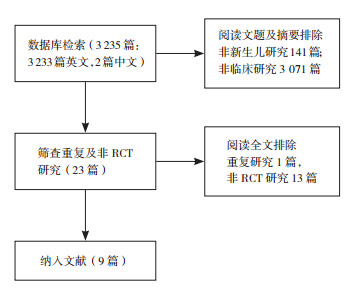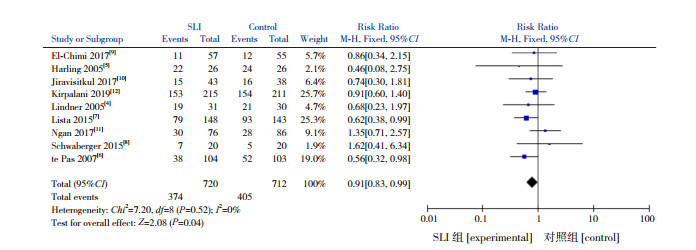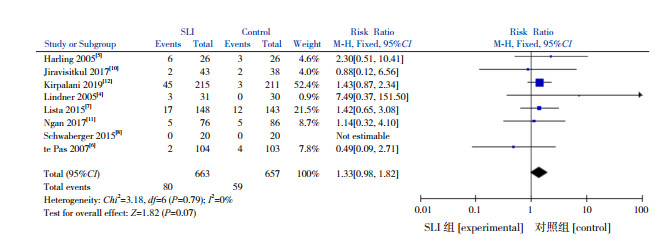持续性肺膨胀(sustained lung inflation, SLI)是一种肺复张方法。其主要通过给予足够的气道压力,且屏气一段时间,使塌陷的肺泡充分复张,有助于肺泡的气体均匀分布,增加肺泡的稳定性,显著增加肺容积,减少死腔通气,并且延长气体交换时间,改善肺顺应性,增加了肺部氧合[1-3]。近年来国内外针对早产儿使用SLI进行相关的临床研究显示,SLI应用于早产儿有助于减少插管和机械通气,且未增加肺损伤及气胸的发生[4-12]。有学者针对SLI相关的临床研究进行系统评价,显示SLI可减少机械通气且并未增加支气管肺发育不良(BPD)或死亡的发生[13]。然而最新的欧洲新生儿呼吸窘迫综合征指南并不推荐SLI运用于早产儿复苏中,在获得更多的循证医学证据前,SLI仅用于临床研究中[14]。SLI在早产儿中的使用尚存在一定的争议。因此,本研究主要结合最新的临床研究,对SLI在胎龄 < 34周早产儿中应用效果进行系统评价,为其临床应用提供循证医学证据。
1 资料与方法 1.1 文献纳入标准(1)研究类型:国内外公开发表的随机临床对照研究,不限国家及地区,限定语种为中文和英文。
(2)研究对象:胎龄 < 34周早产儿。
(3)干预措施:SLI组及对照组均予常规治疗及护理。在此基础上,SLI组使用SLI处理,压力与持续时间不限制,其后接无创正压通气(CPAP)辅助呼吸或者经鼻间歇正压通气(NIPPV)辅助呼吸,而对照组仅给予CPAP辅助通气或NIPPV辅助通气。
1.2 文献排除标准(1)研究对象合并先天性畸形(如先天性膈疝、先天性肺部畸形、严重先天性心脏病)的文献。
(2)无明确诊断标准的文献。
(3)结局指标不明确、不能提供有效的可供参考的数据的文献。
(4)重复发表的文献。
1.3 结局指标(1)72 h内需气管插管接机械通气率;(2)肺表面活性物质使用率;(3)病死率;(4)并发症的发生率:如BPD、气胸、Ⅲ~Ⅵ级脑室内出血等。
1.4 文献检索由本文的两位作者分别独立在PubMed、Embase、Cochrane图书馆、中国知网、万方数据库、中国生物医学文献数据库、中国期刊全文数据库、中国科技期刊数据库(维普)进行检索,检索时限为数据库建立至2019年9月1日。英文检索词为“sustained lung inflation”“lung inflation”“newborn”“infant”。中文检索词为:“持续性肺膨胀”“持续性肺充气”“新生儿”。两位作者分别独立对搜索的文献进行筛选,筛选流程及结果见图 1。有争议的文献通过第三位作者进行评定是否纳入。

|
图 1 文献筛选流程图 |
采用RevMan 5.3软件进行Meta分析和异质性检验。如果各研究间无明显的异质性(P > 0.10,I2 < 50%),采用固定效应模型分析;如果各研究间存在显著异质性(P≤0.10,I2≥50%),则采用随机效应模型分析。二分类变量的效应量采用风险比(RR)及其95%置信区间(CI)表示。P < 0.05时认为结果具有统计学意义。
2 结果 2.1 纳入研究的基本信息初步筛选共获得文献3 235篇,最终共筛出9篇文献纳入研究,均来源于国外研究。合计1 432例早产儿(胎龄:23~33.7周),其中SLI组720例,对照组712例。对纳入Meta分析的研究进行改良Jadad量表评分[15],结果显示所纳入的9项研究均为高质量研究(均大于4分)。纳入研究的基本信息见表 1。
| 表 1 纳入研究的基本信息 |
|
|
共9项研究对72 h内机械通气率进行了分析。Meta分析显示各研究之间具有同质性(P=0.52,I2=0%),采用固定效应模型进行统计学分析。结果显示:SLI组72 h内机械通气率显著低于对照组(51.9% vs 56.9%),两组比较差异具有统计学意义(RR=0.91,P=0.04,95%CI:0.83~0.99),见图 2。

|
图 2 SLI组与对照组72 h内机械通气率比较的森林图 |
一共有8项研究对患儿死亡数据进行分析。Meta分析显示各研究之间具有同质性(P=0.79,I2=0%),采用固定效应模型进行统计分析。结果显示,SLI组有80例患儿死亡(病死率12.0%),对照组有59例死亡(病死率9.0%),两组病死率的比较差异无统计学意义(RR=1.33,P=0.07,95%CI:0.98~1.82),见图 3。

|
图 3 SLI组与对照组病死率比较的森林图 |
一共有6项研究对肺表面活性物质使用率进行统计。Meta分析显示各研究间具有同质性(P=0.70,I2=0%),采用固定效应模型进行统计分析。结果显示,SLI组肺表面活性物质使用率(33.6%)与对照组(34.1%)比较差异无统计学意义(RR=0.99,P=0.87,95%CI:0.87~1.13)。见图 4。

|
图 4 SLI组与对照组肺表面活性物质使用率比较的森林图 |
各研究间无明显的异质性(P > 0.10,I2 < 50%),采用固定效应模型分析。Meta分析结果显示,两组早产儿并发症,包括BPD、气胸、Ⅲ~Ⅳ级颅内出血发生率的比较差异无统计学意义(均P > 0.05),见图 5~7。

|
图 5 SLI组与对照组BPD发生率比较的森林图 |

|
图 6 SLI组与对照组气胸发生率比较的森林图 |

|
图 7 SLI组与对照组Ⅲ~Ⅵ级颅内出血发生率比较的森林图 |
胎龄是影响SLI作用的重要因素之一。本Meta分析纳入的9项研究中,仅两项研究将胎龄限制于28~34周(早期早产儿)[8-9],而其余研究纳入的研究对象既包括早期早产儿,也包括极早早产儿(胎龄 < 28周)。将该两项研究排除后,各项统计学指标与排除前一致(表 2)。
| 表 2 敏感性分析 |
|
|
SLI是一种肺复张方法,新生儿复苏时给予SLI有利于改善肺部氧合情况[1-2, 16]。近年来国外学者针对SLI发表多篇回顾性及前瞻随机对照研究。Lista等[17]回顾性分析发现,使用SLI的89例早产儿气管插管接机械通气率及机械通气时间、肺表面活性物质使用率及激素使用率等较对照组低,提示SLI可能减少机械通气的使用。相关随机对照研究结果也发现SLI的运用可减少早产儿机械通气且并未增加其余相关并发症如气胸等的风险[4, 6-7]。然而,2019年的欧洲相关指南提及,由于SLI的使用并无显著的益处,并未推荐使用于临床,仅限用于临床研究中[14]。
本Meta分析显示,与对照组比较,SLI组72 h内需使用气管插管接机械通气率较低,两组比较差异具有统计学意义,这提示SLI可减少机械通气的使用,与其他学者研究结果相符[7]。从两组死亡情况的比较中可见,SLI组病死率较对照组增加,但两组差异并无统计学意义。Kirpalani等[12]纳入胎龄23~26周极早早产儿进行SLI研究,SLI组早产儿接受两次SLI处理(第一次压力为20 cm H2O,持续时间为15 s;第二次压力为25 cm H2O,时间同前),结果显示SLI并未降低BPD或死亡的发生,且不推荐SLI运用于极早早产儿(胎龄 < 28周)。本研究纳入的9项随机对照研究中,仅两项研究将胎龄限制于早期早产儿(胎龄28~34周)[8-9],其余文献中包含早期早产儿及极早早产儿。而将该两项研究排除后所获得的敏感性分析结果是一致的,提示本Meta分析结果是稳健的。
本Meta分析同时对早产儿其余相关并发症进行对比分析,发现SLI并未增加早产儿气胸、Ⅲ~Ⅳ级颅内出血及BPD发生的风险,这与其他学者的研究结果相似[4, 6-8, 18]。SLI通过短暂的肺膨胀,采用的压力及时间安全,增加肺部容量改善通气的同时并不增加气胸的风险。SLI对早产儿的循环系统影响尚未明确,有学者认为在有效的SLI作用下,心率恢复更快,且随着动脉血氧饱和度的恢复,脑组织氧饱和度随之增加[19]。一项早产动物实验研究显示,SLI可稳定脑组织氧的传递,并可能防止脑缺氧[20]。SLI对于早产儿远期的影响暂无相关研究的支持,尚需要更多的大样本随机对照研究。
本研究的不足在于纳入的随机对照研究中所使用SLI的压力及时间不一致,这可能影响Meta分析结果,且仅一项研究(Kirpalani等[12])提到进行了双盲法研究。另外,截止目前所搜索的相关文献中,无国内文献,且所纳入的研究中SLI的使用除Schwaberger等[8]于NICU中实施外,其余均在产房中使用,这不符合发展中国家的国情。
综上,本Meta分析显示,SLI可减低 < 34周早产儿机械通气的使用且未增加相关并发症的发生风险,但仍需要更多的高质量的随机对照研究去证实。
| [1] |
te Pas AB, Siew M, Wallace MJ, et al. Establishing functional residual capacity at birth:the effect of sustained inflation and positive end-expiratory pressure in a preterm rabbit model[J]. Pediatr Res, 2009, 65(5): 537-541. (  0) 0) |
| [2] |
te Pas AB, Siew M, Wallace MJ, et al. Effect of sustained inflation length on establishing functional residual capacity at birth in ventilated premature rabbits[J]. Pediatr Res, 2009, 66(3): 295-300. (  0) 0) |
| [3] |
杨传忠, 朱小瑜. 持续性肺膨胀在新生儿复苏中的应用[J]. 中华实用儿科临床杂志, 2017, 32(14): 1041-1044. DOI:10.3760/cma.j.issn.2095-428X.2017.14.001 (  0) 0) |
| [4] |
Lindner W, Högel J, Pohlandt F. Sustained pressure-controlled inflation or intermittent mandatory ventilation in preterm infants in the delivery room? A randomized, controlled trial on initial respiratory support via nasopharyngeal tube[J]. Acta Paediatr, 2005, 94(3): 303-309. (  0) 0) |
| [5] |
Harling AE, Beresford MW, Vince GS, et al. Does sustained lung inflation at resuscitation reduce lung injury in the preterm infant?[J]. Arch Dis Child Fetal Neonatal Ed, 2005, 90(5): F406-F410. DOI:10.1136/adc.2004.059303 (  0) 0) |
| [6] |
te Pas AB, Walther FJ. A randomized, controlled trial of delivery-room respiratory management in very preterm infants[J]. Pediatrics, 2007, 120(2): 322-329. (  0) 0) |
| [7] |
Lista G, Boni L, Scopesi F, et al. Sustained lung inflation at birth for preterm infants:a randomized clinical trial[J]. Pediatrics, 2015, 135(2): e457-e464. DOI:10.1542/peds.2014-1692 (  0) 0) |
| [8] |
Schwaberger B, Pichler G, Avian A, et al. Do sustained lung inflations during neonatal resuscitation affect cerebral blood volume in preterm infants? A randomized controlled pilot study[J]. PLoS One, 2015, 10(9): e0138964. DOI:10.1371/journal.pone.0138964 (  0) 0) |
| [9] |
El-Chimi MS, Awad HA, El-Gammasy TM, et al. Sustained versus intermittent lung inflation for resuscitation of preterm infants:a randomized controlled trial[J]. J Matern Fetal Neonatal Med, 2017, 30(11): 1273-1278. DOI:10.1080/14767058.2016.1210598 (  0) 0) |
| [10] |
Jiravisitkul P, Rattanasiri S, Nuntnarumit P. Randomised controlled trial of sustained lung inflation for resuscitation of preterm infants in the delivery room[J]. Resuscitation, 2017, 111: 68-73. DOI:10.1016/j.resuscitation.2016.12.003 (  0) 0) |
| [11] |
Ngan AY, Cheung PY, Hudson-Mason A, et al. Using exhaled CO 2 to guide initial respiratory support at birth:a randomised controlled trial[J]. Arch Dis Child Fetal Neonatal Ed, 2017, 102(6): F525-F531. DOI:10.1136/archdischild-2016-312286 (  0) 0) |
| [12] |
Kirpalani H, Ratcliffe SJ, Keszler M, et al. Effect of sustained inflations vs intermittent positive pressure ventilation on bronchopulmonary dysplasia or death among extremely preterm infants:the SAIL randomized clinical trial[J]. JAMA, 2019, 321(12): 1165-1175. DOI:10.1001/jama.2019.1660 (  0) 0) |
| [13] |
Schmölzer GM, Kumar M, Aziz K, et al. Sustained inflation versus positive pressure ventilation at birth:a systematic review and meta-analysis[J]. Arch Dis Child Fetal Neonatal Ed, 2015, 100(4): F361-F368. DOI:10.1136/archdischild-2014-306836 (  0) 0) |
| [14] |
Sweet DG, Carnielli V, Greisen G, et al. European consensus guidelines on the management of respiratory distress syndrome-2019 update[J]. Neonatology, 2019, 115(4): 432-450. DOI:10.1159/000499361 (  0) 0) |
| [15] |
Oremus M, Wolfson C, Perrault A, et al. Interrater reliability of the modified Jadad quality scale for systematic reviews of Alzheimer's disease drug trials[J]. Dement Geriatr Cogn Disord, 2001, 12(3): 232-236. DOI:10.1159/000051263 (  0) 0) |
| [16] |
te Pas AB, Walther FJ. Ventilation of very preterm infants in the delivery room[J]. Curr Pediatr Rev, 2006, 2(3): 187-197. DOI:10.2174/157339606778019693 (  0) 0) |
| [17] |
Lista G, Fontana P, Castoldi F. Does sustained lung inflation at birth improve outcome of preterm infants at risk for respiratory distress syndrome?[J]. Neonatology, 2011, 99(1): 45-50. DOI:10.1159/000298312 (  0) 0) |
| [18] |
Fischer HS, Schmölzer GM, Cheung PY, et al. Sustained inflations and avoiding mechanical ventilation to prevent death or bronchopulmonary dysplasia:a meta-analysis[J]. Eur Respir Rev, 2018, 27(150): pii:180083. DOI:10.1183/16000617.0083-2018 (  0) 0) |
| [19] |
Fuchs H, Lindner W, Buschko A, et al. Cerebral oxygenation in very low birth weight infants supported with sustained lung inflations after birth[J]. Pediatr Res, 2011, 70(2): 176-180. (  0) 0) |
| [20] |
Sobotka KS, Hooper SB, Allison BJ, et al. An initial sustained inflation improves the respiratory and cardiovascular transition at birth in preterm lambs[J]. Pediatr Res, 2011, 70(1): 56-60. (  0) 0) |
 2020, Vol. 22
2020, Vol. 22


